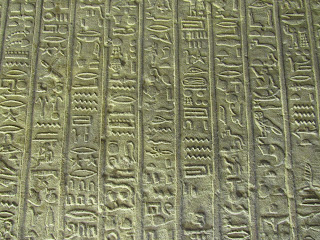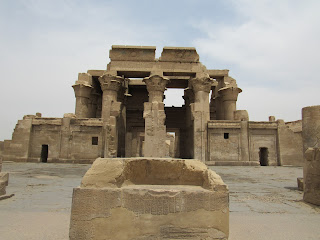After my two days in Luxor, I took a two day tour to Aswan, which included stops at Edfu Temple, Kom Ombo, Philae Temple, and Abu Simbel.
Edfu Temple
My first stop on my journey to Aswan, where I stayed the night, was Edfu Temple, a Ptolemaic Temple dedicated to Horus. The entrance to this temple is flanked by two falcon statues, the sacred animal of the god. The pylon entrance to the temple is decorated with depictions of the pharaoh smiting the enemies of Egypt under the watchful gaze of Horus, the protector of Egyptian pharaohs.
 |
| Edfu Temple |
Every inch of the inside of this temple is covered with hieroglyphics and depictions of the gods and sacrifices. Scenes include the building and dedication of the temple for Horus, the recipe for different perfumes, and the back of the temple contains dozens of rooms dedicated to different gods of Ancient Egypt. The temple also has a rare depiction of the chaos god Set, who is depicted as a hippopotamus being conquered by Horus along the outside of the temple.
 |
| Hieroglyphic Depictions |
 |
| Seshat and Pharaoh laying Temple Foundation |
 |
| Bats! |
Kom Ombo
My next stop was at the double temple of Kom Ombo. This temple is split down the middle with the crocodile god, Sobek, worshiped on one side, and the falcon god, Horus, on the other. These two sides mirror each other, with the depictions interchangeable except for the main god depicted. The double temple of Kom Ombo is unique in this way, and was the major cult for the worship of crocodiles. The temple site also includes a crocodile museum that contains the mummified remains of dozens of crocodiles that had been buried at the site of the temple. The bodies were so well preserved and it was really cool to see the 2000 year old crocodiles that lived within the sanctuary of the temple and housed the god.
 |
| Kom Ombo |
Last semester in my Ancient Greek and Roman Medicine class, we discussed the medicinal instruments depicted at the temple of Kom Ombo. I did not put the two together and I am so thankful that my tour guide pointed out the carvings to me. On the left of the carvings are two women seating on birthing chairs, while the primary component of the depiction are the instruments which include scissors, scalpels, bleeding cups, tweezers, enema instruments, and cautery irons. The most important instrument depicted, however, is the scale (which is located on the top right of the third row) as scales were used in Roman medicine to measure medicine, not before that period, allowing historians to date this section of the temple to the Roman Period of occupation.
 |
| Medicinal Instruments of Kom Ombo |
Philae Temple
After a quick stop in the sweltering heat (110 degrees) to the Aswan High Dam, which is used to control the flooding of the Nile River, I took a boat to the Philae Temple. This temple was moved in the 1970s from its original island, upon which the temple was flooded with the creation to the Aswan High Dam. UNESCO worked with the Egyptian government in order to move the temple to safety as it was designated as a World Heritage Site. In fact, if you look closely at the picture below, you can make out a slight difference in color of the temple's walls, which became discolored from the water damage. The temple was dedicated to Isis, and includes depictions of her along with her husband Osiris, her son Horus, and his wife, Hathor. The temple is believed to be the last site in which the religion of the Egyptian pantheon was worshiped, and following the conversion to Christianity, the temple became a church, including an altar and carvings of the cross.
 |
| Philae Temple |
Abu Simbel
The following day, I was picked up three in the morning for the drive to Abu Simbel, a temple complex built by Ramesses II the Great. The temple complex was constructed by Ramesses after his "victory" at the Battle of Kadesh (it was actually a draw from which we get the first recorded peace treaty). Not only is the temple complex giant but it is also my favorite temples that I visited in Egypt. The inside of the temples are richly decorated depicting not only the gods of Egypt but also scenes from the Battle of Kadesh. Just like Philae Temple, the Abu Simbel temples were submerged after the construction of the Aswan Dam, and the temples were deconstructed and subsequently moved up the cliff face to their current positions. The coolest aspect of this temple complex is that the sanctuary of the temple contains statues of three gods - Ptah, Ammun- Ra, Ra-Horakhty - and Ramesses' deified self. The architects of the temple positioned it so that on October 22 and February 22 (his birthday and coronation day respectively) the rays of the sun would light up the statues of the sanctuary, except for the statue of Ptah, a god of the underworld. God(s) bless Egyptian engineering. Today, with the relocation of the temple, this solar alignment occurs on the 21st of October and February.
The smaller companion temple was built for Neferari, Ramesses the Great's chief wife, with whom he had a deep love affair. The temples' location are in honor of his wife's lineage, as she was of Nubian descent (the territory of modern day Southern Egypt and Northern Sudan). The face of this temple contains six statues, four of Ramesses and two of Nefertari. Though he graced the face of the temple with more statues of himself than of his wife, the statues of Nefertari are the same size as those of Ramesses, designating her significance as Egyptian women are always depicted as smaller. The couple are flanked with small statues of their children together, and within the temple, Hathor is worshiped alongside of Nefertari.


No comments:
Post a Comment